check engine YAMAHA XV1900A 2012 Owners Manual
[x] Cancel search | Manufacturer: YAMAHA, Model Year: 2012, Model line: XV1900A, Model: YAMAHA XV1900A 2012Pages: 88, PDF Size: 1.91 MB
Page 6 of 88

TABLE OF CONTENTSSAFETY INFORMATION ..................1-1
DESCRIPTION ..................................2-1
Left view ..........................................2-1
Right view ........................................2-2
Controls and instrume nts.................2-3
INSTRUMENT AND CONTROL
FUNCTIONS .......................................3-1
Immobilizer system .... .....................3-1
Main switch/steering lock ................3-2
Indicator lights and warning lights ............................................3-4
Multi-function meter unit .................3-5
Anti-theft alarm (optional) .............3-10
Handlebar switches ......................3-10
Clutch lever ...................................3-12
Shift pedal .... ............................ .....3-12
Brake lever ...................................3-12
Brake pedal ..................................3-13
Fuel tank cap ................................3-13
Fuel ...............................................3-14
Fuel tank breather/overflow
hose ..........................................3-15
Catalytic converter ........................3-15
Rider seat .....................................3-16
Helmet holder ...............................3-17
Adjusting the shock absorber
assembly ...................................3-18
EXUP system ...............................3-19
Sidestand ......................................3-20 Ignition circuit cut-
off system ........ 3-20
Auxiliary DC connector ................. 3-22
FOR YOUR SAFETY –
PRE-OPERATION CHECKS ............. 4-1
OPERATION AND IMPORTANT
RIDING POINTS ................................. 5-1
Starting the engine ......................... 5-1
Shifting ........................................... 5-2
Tips for reducing fuel consumption ............................... 5-3
Engine break-in .............................. 5-3
Parking ........................................... 5-4
PERIODIC MAINTENANCE AND
ADJUSTMENT ................................... 6-1
Owner’s tool kit ............................... 6-2
Periodic maintenance chart for the emission control system ............. 6-3
General maintenance and lubrication chart .......................... 6-4
Checking the spark plugs ............... 6-8
Engine oil and oil filter cartridge ..... 6-9
Transfer case oil ........................... 6-12
Air filter element ........................... 6-12
Checking the throttle grip free play ........................................... 6-13
Valve clearance ............................ 6-13
Tires ............................................. 6-13
Cast wheels .................................. 6-15 Clutch lever .................................. 6-15
Checking the brake lever free
play ........................................... 6-16
Brake light switches ..................... 6-16
Checking the front and rear brake
pads .......................................... 6-17
Checking the brake and clutch fluid levels ................................. 6-17
Changing the brake and clutch fluids ......................................... 6-19
Drive belt slack ............................ 6-19
Checking and lubricating the cables ....................................... 6-20
Checking and lubricating the
throttle grip and cable ............... 6-20
Checking and lubricating the brake and shift pedals .............. 6-21
Checking and lubricating the brake and clutch levers ............ 6-21
Checking and lubricating the
sidestand .................................. 6-22
Lubricating the rear suspension ... 6-22
Checking the front fork ................. 6-23
Checking the steering .................. 6-23
Checking the wheel bearings ....... 6-24
Battery ......................................... 6-24
Replacing the fuses ..................... 6-25
Replacing a headlight bulb .......... 6-26
Tail/brake light ............................. 6-29
Replacing a turn signal light bulb ........................................... 6-29U1CRE1E0.book Page 1 Mond ay, October 3, 2011 8:45 AM
Page 10 of 88

SAFETY INFORMATION
1-3
1
●
Do not run engine in poorly venti-
lated or partially enclosed areas
such as barns, garages, or car-
ports.
●
Do not run engine outdoors where
engine exhaust can be drawn into
a building through openings such
as windows and doors.
Loading
Adding accessories or cargo to your
motorcycle can adversely affect stabili-
ty and handling if the weight distribution
of the motorcycle is changed. To avoid
the possibility of an accident, use ex-
treme caution when adding cargo or
accessories to your motorcycle. Use
extra care when riding a motorcycle
that has added cargo or accessories.
Here, along with the information about
accessories below, are some general
guidelines to follow if loading cargo to
your motorcycle:
The total weight of the operator, pas-
senger, accessories and cargo must
not exceed the maximum load limit.
Operation of an overloaded vehicle
could cause an accident. When loading within this weight limit,
keep the following in mind:
●
Cargo and accessory weight
should be kept as low and close to
the motorcycle as possible. Se-
curely pack your heaviest items as
close to the center of the vehicle as
possible and make sure to distrib-
ute the weight as evenly as possi-
ble on both sides of the motorcycle
to minimize imbalance or instabili-
ty.
●
Shifting weights can create a sud-
den imbalance. Make sure that ac-
cessories and cargo are securely
attached to the motorcycle before
riding. Check accessory mounts
and cargo restraints frequently.
Properly adjust the suspension for your load (suspension-ad-
justable models only), and
check the condition and pres-
sure of your tires.
Never attach any large or heavy items to the handlebar, front
fork, or front fender. These items, including such cargo as
sleeping bags, duffel bags, or
tents, can create unstable han-
dling or a slow steering re-
sponse.
●
This vehicle is not designed to
pull a trailer or to be attached to
a sidecar.
Genuine Yamaha Accessories
Choosing accessories for your vehicle
is an important decision. Genuine
Yamaha accessories, which are avail- able only from a Yamaha dealer, have
been designed, tested, and approved
by Yamaha for use on your vehicle.
Many companies with no connection to
Yamaha manufacture parts and acces- sories or offer other modifications for
Yamaha vehicles. Yamaha is not in a position to test the products that these
aftermarket companies produce.
Therefore, Yamaha can neither en-
dorse nor recommend the use of ac-
cessories not sold by Yamaha or
modifications not specifically recom-
mended by Yamaha, even if sold and
installed by a Yamaha dealer.
Maximum load: 203 kg (448 lb)
U1CRE1E0.book Page 3 Mond ay, October 3, 2011 8:45 AM
Page 19 of 88
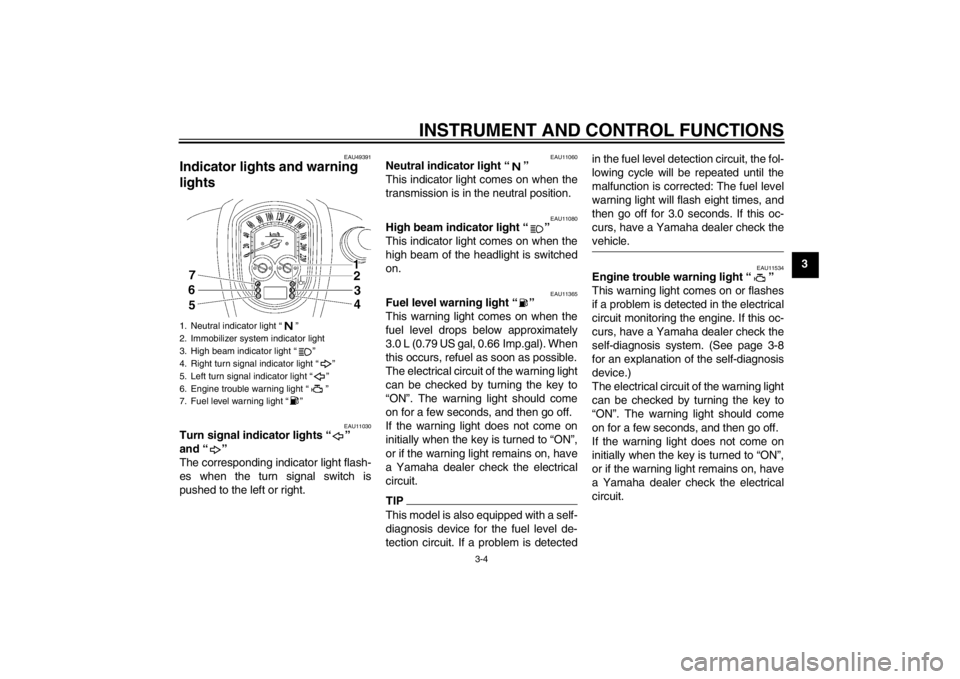
INSTRUMENT AND CONTROL FUNCTIONS
3-4
3
EAU49391
Indicator lights and warning
lights
EAU11030
Turn signal indicator lights “ ”
and “ ”
The corresponding indicator light flash-
es when the turn signal switch is
pushed to the left or right.
EAU11060
Neutral indicator light “ ”
This indicator light comes on when the
transmission is in the neutral position.
EAU11080
High beam indicator light “ ”
This indicator light comes on when the
high beam of the headlight is switched
on.
EAU11365
Fuel level warning light “ ”
This warning light comes on when the
fuel level drops below approximately
3.0 L (0.79 US gal, 0.66 Imp.gal). When
this occurs, refuel as soon as possible.
The electrical circuit of the warning light
can be checked by turning the key to
“ON”. The warning light should come
on for a few seconds, and then go off.
If the warning light does not come on
initially when the key is turned to “ON”,
or if the warning light remains on, have
a Yamaha dealer check the electrical
circuit.TIPThis model is also equipped with a self-
diagnosis device for the fuel level de-
tection circuit. If a problem is detected in the fuel level detection circuit, the fol-
lowing cycle will be repeated until the
malfunction is corrected: The fuel level
warning light will flash eight times, and
then go off for 3.0 seconds. If this oc-
curs, have a Yamaha dealer check the
vehicle.
EAU11534
Engine trouble warning light “ ”
This warning light comes on or flashes
if a problem is detected in the electrical
circuit monitoring the engine. If this oc-
curs, have a Yamaha dealer check the
self-diagnosis system. (See page 3-8
for an explanation of the self-diagnosis
device.)
The electrical circuit of the warning light
can be checked by turning the key to
“ON”. The warning light should come
on for a few seconds, and then go off.
If the warning light does not come on
initially when the key is turned to “ON”,
or if the warning light remains on, have
a Yamaha dealer check the electrical
circuit.
1. Neutral indicator light “ ”
2. Immobilizer system indicator light
3. High beam indicator light “ ”
4. Right turn signal indicator light “ ”
5. Left turn signal indicator light “ ”
6. Engine trouble warning light “ ”
7. Fuel level warning light “ ”
U1CRE1E0.book Page 4 Mond
ay, October 3, 2011 8:45 AM
Page 23 of 88
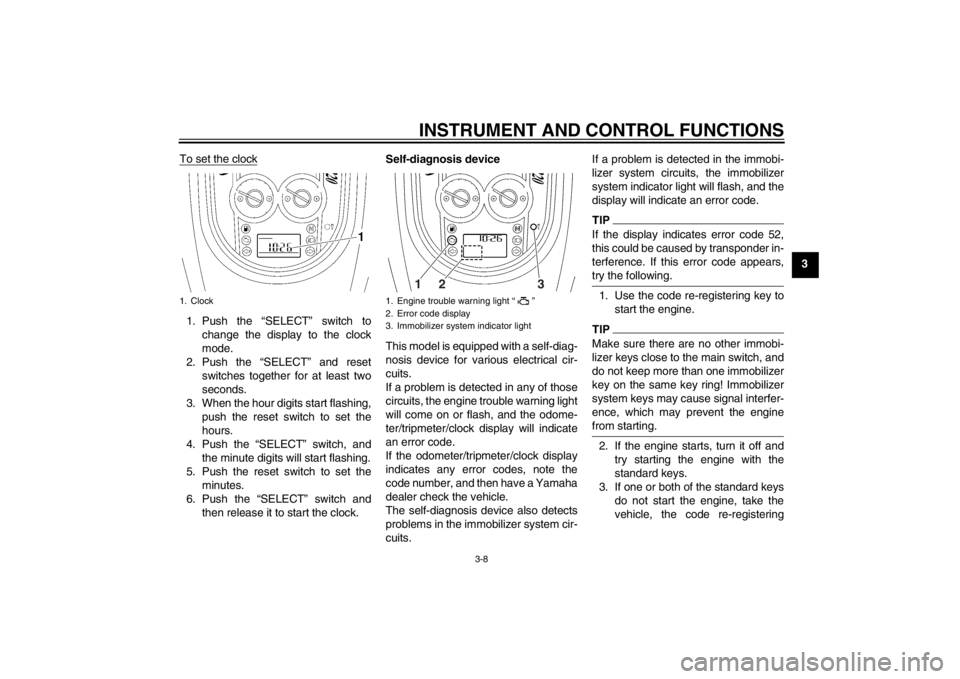
INSTRUMENT AND CONTROL FUNCTIONS
3-8
3
To set the clock
1. Push the “SELECT” switch to
change the display to the clock
mode.
2. Push the “SELECT” and reset switches together for at least two
seconds.
3. When the hour digits start flashing, push the reset switch to set the
hours.
4. Push the “SELECT” switch, and the minute digits will start flashing.
5. Push the reset switch to set the minutes.
6. Push the “SELECT” switch and then release it to start the clock. Self-diagnosis device
This model is equipped with a self-diag-
nosis device for various electrical cir-
cuits.
If a problem is detected in any of those
circuits, the engine trouble warning light
will come on or flash, and the odome-
ter/tripmeter/clock display will indicate
an error code.
If the odometer/tripmeter/clock display
indicates any error codes, note the
code number, and then have a Yamaha
dealer check the vehicle.
The self-diagnosis
device also detects
problems in the immobilizer system cir-
cuits. If a problem is detected in the immobi-
lizer system circui
ts, the immobilizer
system indicator light will flash, and the
display will indicate an error code.
TIPIf the display indicates error code 52,
this could be caused by transponder in-
terference. If this error code appears,
try the following.1. Use the code re-registering key to start the engine.TIPMake sure there are no other immobi-
lizer keys close to the main switch, and
do not keep more than one immobilizer
key on the same key ring! Immobilizer
system keys may cause signal interfer-
ence, which may prevent the engine
from starting.2. If the engine starts, turn it off andtry starting the engine with the
standard keys.
3. If one or both of the standard keys do not start the engine, take the
vehicle, the code re-registering
1. Clock
1. Engine trouble warning light “ ”
2. Error code display
3. Immobilizer system indicator light
1
2
3
U1CRE1E0.book Page 8 Mond ay, October 3, 2011 8:45 AM
Page 24 of 88
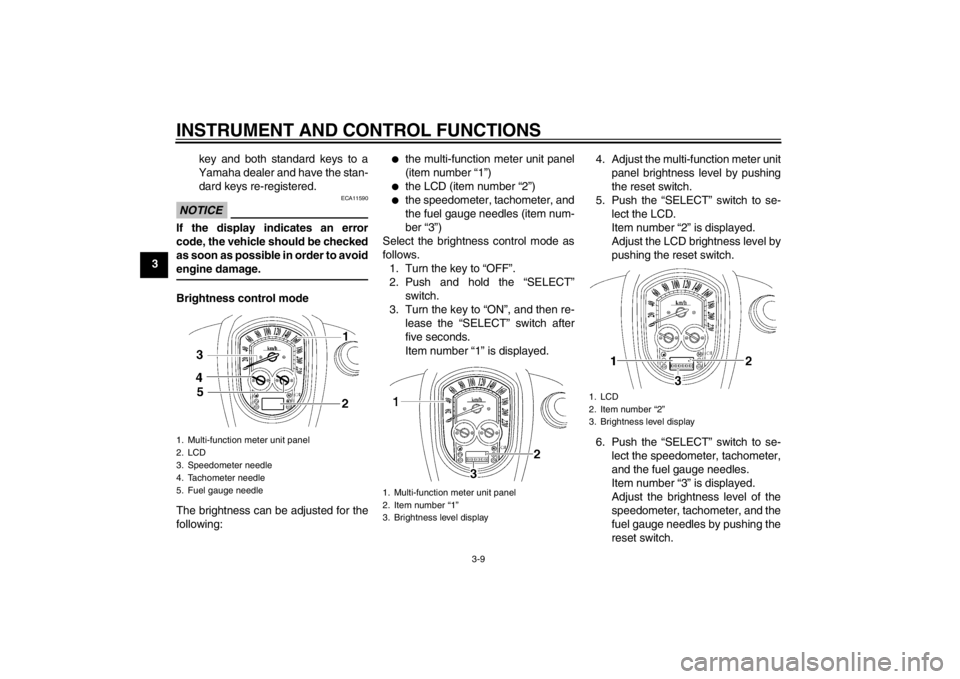
INSTRUMENT AND CONTROL FUNCTIONS
3-9
3key and both standard keys to a
Yamaha dealer and have the stan- dard keys re-registered.
NOTICE
ECA11590
If the display indicates an error
code, the vehicle should be checked
as soon as possible in order to avoid
engine damage.Brightness control mode
The brightness can be adjusted for the
following:
●
the multi-function meter unit panel
(item number “1”)
●
the LCD (item number “2”)
●
the speedometer, tachometer, and
the fuel gauge needles (item num-
ber “3”)
Select the brightness control mode as
follows. 1. Turn the key to “OFF”.
2. Push and hold the “SELECT” switch.
3. Turn the key to “ON”, and then re- lease the “SELECT” switch after
five seconds.
Item number “1” is displayed. 4. Adjust the multi-function meter unit
panel brightness level by pushing
the reset switch.
5. Push the “SELECT” switch to se- lect the LCD.
Item number “2” is displayed.
Adjust the LCD brightness level by
pushing the reset switch.
6. Push the “SELECT” switch to se- lect the speedometer, tachometer,
and the fuel gauge needles.
Item number “3” is displayed.
Adjust the brightness level of the
speedometer, tachometer, and the
fuel gauge needles by pushing the
reset switch.
1. Multi-function meter unit panel
2. LCD
3. Speedometer needle
4. Tachometer needle
5. Fuel gauge needle
1. Multi-function meter unit panel
2. Item number “1”
3. Brightness level display
1. LCD
2. Item number “2”
3. Brightness level display
U1CRE1E0.book Page 9 Mond ay, October 3, 2011 8:45 AM
Page 30 of 88
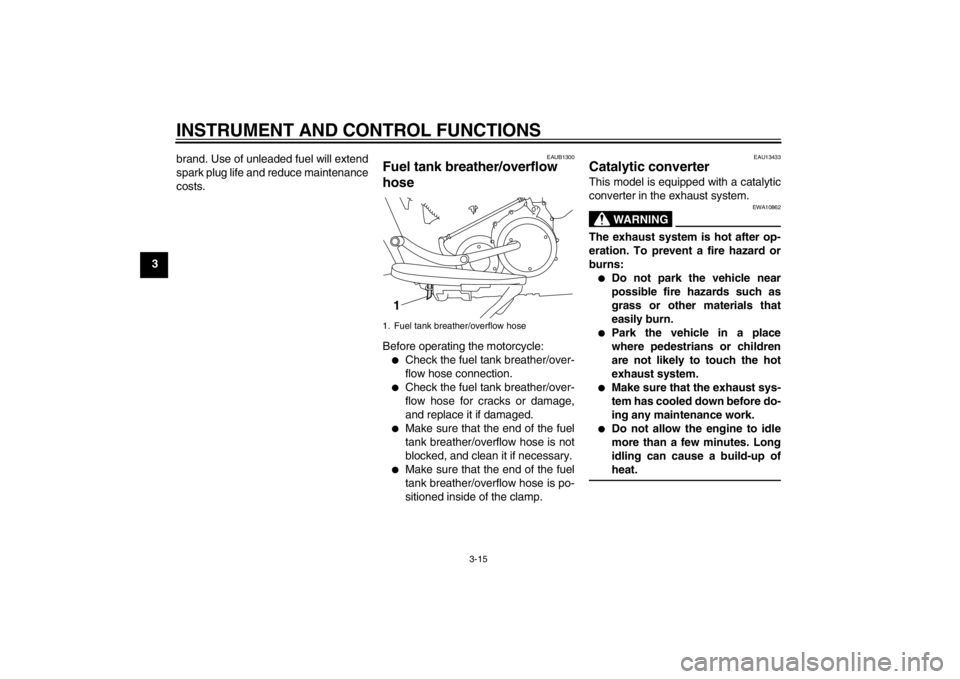
INSTRUMENT AND CONTROL FUNCTIONS
3-15
3brand. Use of unleaded fuel will extend
spark plug life and reduce maintenance
costs.
EAUB1300
Fuel tank breather/overflow
hose Before operating the motorcycle:●
Check the fuel tank breather/over-
flow hose connection.
●
Check the fuel tank breather/over-
flow hose for cracks or damage,
and replace it if damaged.
●
Make sure that the end of the fuel
tank breather/overflow hose is not
blocked, and clean it if necessary.
●
Make sure that the end of the fuel
tank breather/overflow hose is po-
sitioned inside of the clamp.
EAU13433
Catalytic converter This model is equipped with a catalytic
converter in the exhaust system.
WARNING
EWA10862
The exhaust system is hot after op-
eration. To prevent a fire hazard or
burns:●
Do not park the vehicle near
possible fire hazards such as
grass or other materials that
easily burn.
●
Park the vehicle in a place
where pedestrians or children
are not likely to touch the hot
exhaust system.
●
Make sure that the exhaust sys-
tem has cooled down before do-
ing any maintenance work.
●
Do not allow the engine to idle
more than a few minutes. Long
idling can cause a build-up of
heat.
1. Fuel tank breather/overflow hose1
U1CRE1E0.book Page 15 Monday, October 3, 2011 8:45 AM
Page 34 of 88
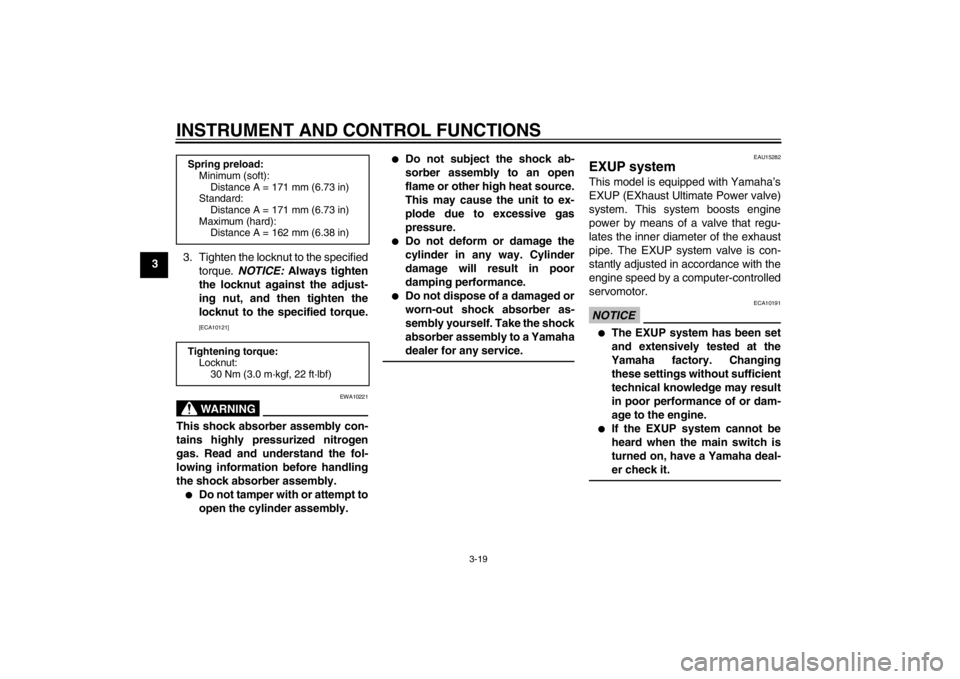
INSTRUMENT AND CONTROL FUNCTIONS
3-19
33. Tighten the locknut to the specified
torque. NOTICE: Always tighten
the locknut against the adjust-
ing nut, and then tighten the
locknut to the specified torque.
[ECA10121]WARNING
EWA10221
This shock absorber assembly con-
tains highly pressurized nitrogen
gas. Read and understand the fol-
lowing information before handling
the shock absorber assembly.●
Do not tamper with or attempt to
open the cylinder assembly.
●
Do not subject the shock ab-
sorber assembly to an open
flame or other high heat source.
This may cause the unit to ex-
plode due to excessive gas
pressure.
●
Do not deform or damage the
cylinder in any way. Cylinder
damage will result in poor
damping performance.
●
Do not dispose of a damaged or
worn-out shock absorber as-
sembly yourself. Take the shock
absorber assembly to a Yamaha
dealer for any service.
EAU15282
EXUP system This model is equipped with Yamaha’s
EXUP (EXhaust Ultimate Power valve)
system. This system boosts engine
power by means of a valve that regu-
lates the inner diameter of the exhaust
pipe. The EXUP system valve is con-
stantly adjusted in accordance with the
engine speed by a computer-controlled
servomotor.NOTICE
ECA10191
●
The EXUP system has been set
and extensively tested at the
Yamaha factory. Changing these settings without sufficient
technical knowledge may result
in poor performance of or dam-
age to the engine.
●
If the EXUP system cannot be
heard when the main switch is
turned on, have a Yamaha deal-
er check it.
Spring preload: Minimum (soft):Distance A = 171 mm (6.73 in)
Standard:
Distance A = 171 mm (6.73 in)
Maximum (hard): Distance A = 162 mm (6.38 in)
Tightening torque: Locknut:
30 Nm (3.0 m·kgf, 22 ft·lbf)
U1CRE1E0.book Page 19 Monday, October 3, 2011 8:45 AM
Page 35 of 88

INSTRUMENT AND CONTROL FUNCTIONS
3-20
3
EAU15305
Sidestand The sidestand is located on the left side
of the frame. Raise the sidestand or
lower it with your foot while holding the
vehicle upright.TIPThe built-in sidestand switch is part of
the ignition circuit cut-off system, which
cuts the ignition in certain situations.
(See the following section for an expla-
nation of the ignition circuit cut-off sys-
tem.)
WARNING
EWA10241
The vehicle must not be ridden with
the sidestand down, or if the side-
stand cannot be properly moved up (or does not stay up), otherwise the
sidestand could contact the ground
and distract the operator, resulting
in a possible loss of control.
Yamaha’s ignition circuit cut-off system has been designed to assist
the operator in fulfilling the respon-
sibility of raising the sidestand be-
fore starting off. Therefore, check this system regularly and have a
Yamaha dealer repair it if it does not function properly.
EAU44892
Ignition circuit cut-off system The ignition circuit cut-off system (com-
prising the sidestand switch, clutch
switch and neutral switch) has the fol-
lowing functions.●
It prevents starting when the trans-
mission is in gear and the side-
stand is up, but the clutch lever is not pulled.
●
It prevents starting when the trans-
mission is in gear and the clutch le-
ver is pulled, but the sidestand is
still down.
●
It cuts the running engine when the
transmission is in gear and the
sidestand is moved down.
Periodically check the operation of the
ignition circuit cut-off system according
to the following procedure.
U1CRE1E0.book Page 20 Monday, October 3, 2011 8:45 AM
Page 36 of 88
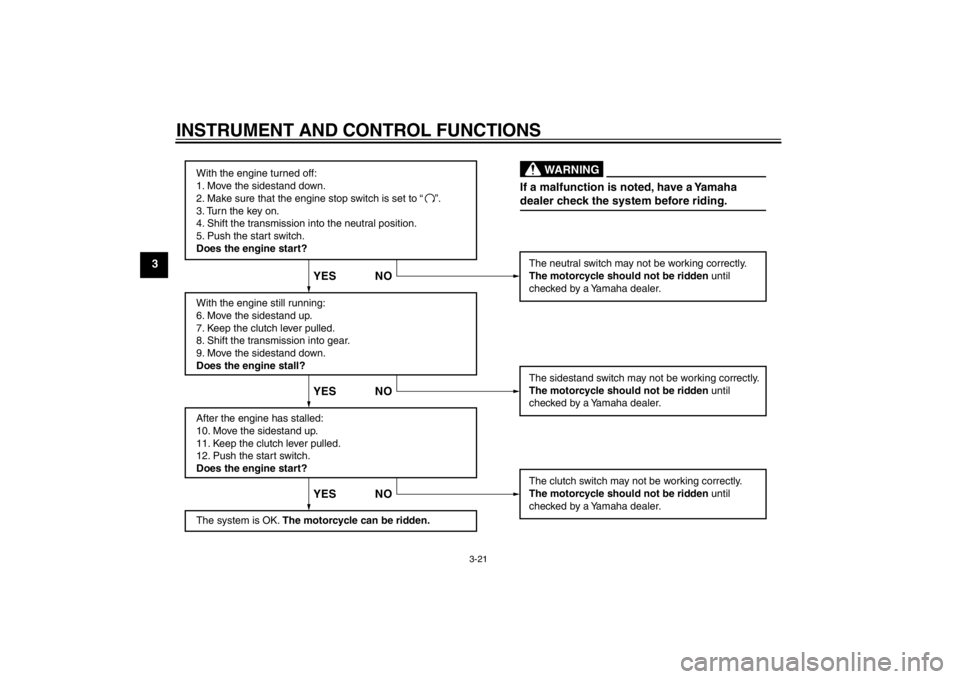
INSTRUMENT AND CONTROL FUNCTIONS
3-21
3
With the engine turned off:
1. Move the sidestand down.
2. Make sure that the engine stop switch is set to “
3. Turn the key on.
4. Shift the transmission into the neutral position.
5. Push the start switch.
Does the engine start?
With the engine still running:
6. Move the sidestand up.
7. Keep the clutch lever pulled.
8. Shift the transmission into gear.
9. Move the sidestand down.
Does the engine stall?
After the engine has stalled:
10. Move the sidestand up.
11. Keep the clutch lever pulled.
12. Push the start switch.
Does the engine start?
The system is OK. The motorcycle can be ridden.The neutral switch may not be working correctly.
The motorcycle should not be ridden until
checked by a Yamaha dealer.
The sidestand switch may not be working correctly.
The motorcycle should not be ridden until
checked by a Yamaha dealer.
The clutch switch may not be working correctly.
The motorcycle should not be ridden until
checked by a Yamaha dealer.
YES NO YES NO YES NO
If a malfunction is noted, have a Yamaha
dealer check the system before riding.
WARNING
”.
U1CRE1E0.book Page 21 Monday, October 3, 2011 8:45 AM
Page 38 of 88
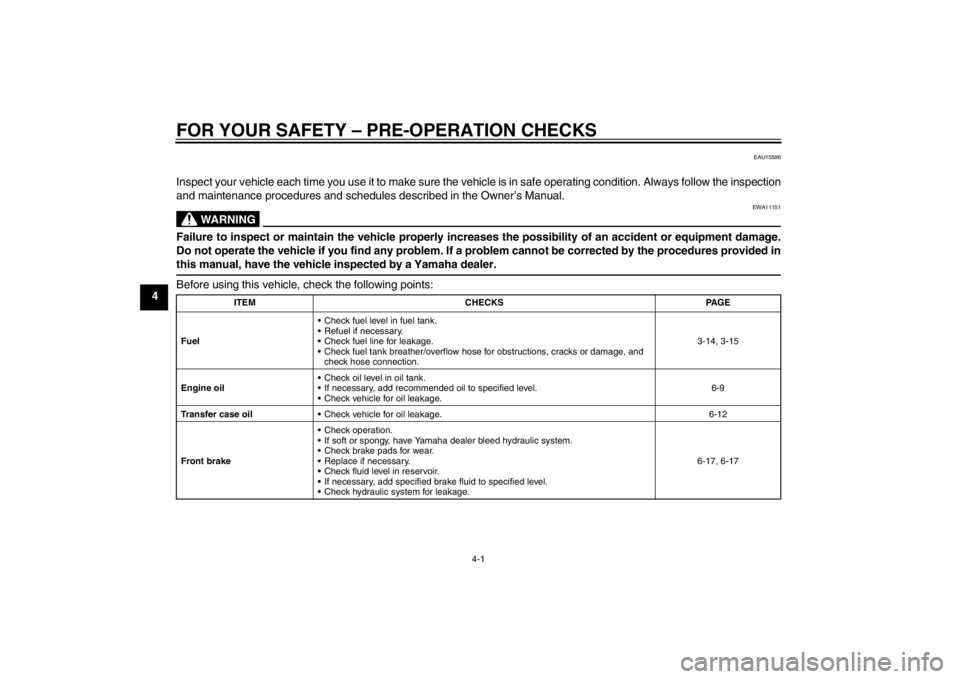
FOR YOUR SAFETY – PRE-OPERATION CHECKS
4-1
4
EAU15596
Inspect your vehicle each time you use it to make sure the vehicle is in safe operating condition. Always follow the inspection
and maintenance procedures and schedules described in the Owner’s Manual.
WARNING
EWA11151
Failure to inspect or maintain the vehicle properly increases the possibility of an accident or equipment damage.
Do not operate the vehicle if you find any problem. If a problem cannot be corrected by the procedures provided in
this manual, have the vehicle inspected by a Yamaha dealer.Before using this vehicle, check the following points:
ITEM CHECKS PAGE
Fuel Check fuel level in fuel tank.
Refuel if necessary.
Check fuel line for leakage.
Check fuel tank breather/overflow hose for obstructions, cracks or damage, and
check hose connection. 3-14, 3-15
Engine oil Check oil level in oil tank.
If necessary, add recommended oil to specified level.
Check vehicle for oil leakage. 6-9
Transfer case oil Check vehicle for oil leakage. 6-12
Front brake Check operation.
If soft or spongy, have Yamaha dealer bleed hydraulic system.
Check brake pads for wear.
Replace if necessary.
Check fluid level in reservoir.
If necessary, add specified brak
e fluid to specified level.
Check hydraulic system for leakage. 6-17, 6-17
U1CRE1E0.book Page 1 Mond
ay, October 3, 2011 8:45 AM